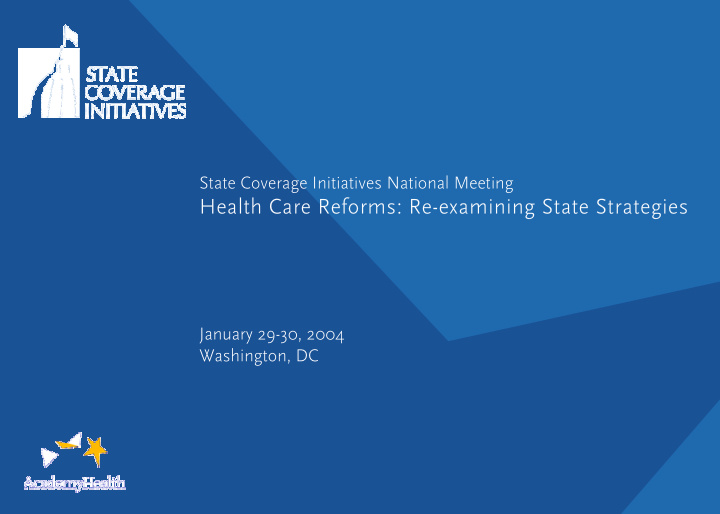



State Coverage Initiatives National Meeting Health Care Reforms: Re-examining State Strategies Health Care Reforms: Re-examining State Strategies January 29-30, 2004 Washington, DC
Healthy NY Gregory V. Serio Superintendent NYS Insurance Department
Background • Market-based • Small businesses initiative • Sole proprietors • Use of tobacco • Individuals funds • Reinsurance to • Eligibility criteria reduce premiums – Uninsured • Streamlined – Most vulnerable / low income / low wage benefit package
Unique Elements Experience is pooled together Everyone pays the same premium rates Small employers Sole proprietors Individuals
Original Stop-Loss Reimbursement $0 for claims over $100,000 $100,000 Claims Reimbursement up to 90% $30,000 $0 for claims under $30,000
Current Stop-Loss Reimbursement $100,000 $0 for claims over $75,000 $75,000 Claims Reimbursement up to 90% $30,000 $0 for claims under $5,000 $5,000
2003 Program Enhancements • Stop-loss corridors • From $30k - $100K to $5k - $75k • Instant premium reduction of 17% • Offered a no-drug option • Can save another 12% of premium
2003 Program Enhancements • Employer crowd-out • Allowed employers that provide only a deminimus contribution toward existing coverage to enroll in HNY (<$50 per employee per month) • Changes for Individuals • Employment Standard eased • HNY is now a qualified plan for the federal Health Coverage Tax Credit
Implementation Regulations • Contract with RFP for fund administrator • Subscriber contract approvals • – Model contract language developed and provided to health plans Rate approvals • Guidance to plans • • training on eligibility and program rules, reporting requirements Establish toll-free hotline / hire answering service • Outreach, public awareness • • advertising • Healthy NY consumer guide • establish website
What We’ve Learned • Healthier population than expected • Claims for first two years of program very low • SL claims corridors: lowered $ 30,000 - $100,000 • $ 5,000 - $ 75,000 • • Crowd-out: 6 month period, rather than 12 months • Program life : should be longer, perhaps 5 year period • Initial program funding for 2 ½ years • It takes time for a new program to take hold • Experience data is not credible until matures
What We’ve Learned • Price is critical • Price sensitive businesses and individuals • Must be affordable in order to attract new lives • Distribution Channels are important • know your audience (potential outreach sources) – small group market - need broker involvement – individuals - television and other programs (referrals)
What We’ve Learned • Recognize indirect benefits of program – Rejuvenated private marketplace discussions • interest in new products for small groups • increased competitiveness of market – Cross-education of other programs • Family Health Plus, Child Health Plus • Programs can work together to educate broadly
Addressing the Needs • Affordability • Provides a lower cost alternative for private purchase of insurance • Availability • Sold by every HMO, state wide • Accessibility • Applications from web, hotline, HMOs, NYS • Administration • Simple application form and process • Simple annual recertification • Won’t lose coverage mid-year due to changes
www.healthyny.com • 2003 Annual Study of the program • prepared by the Lewin Group • program growth, enrollment trends, claims data, pricing impact, feedback from enrollees and health plans
Recommend
More recommend